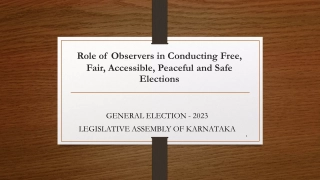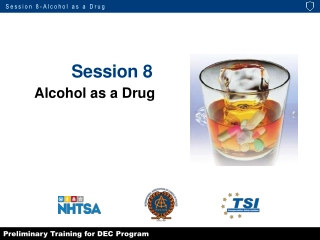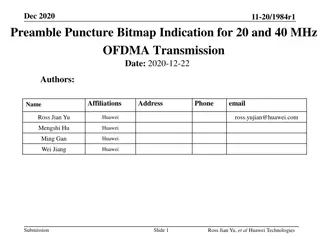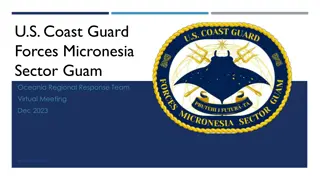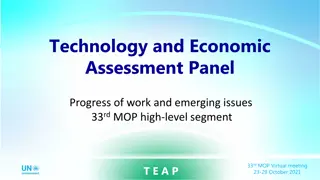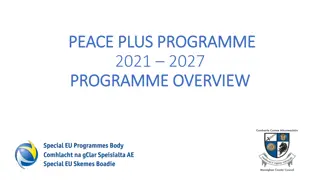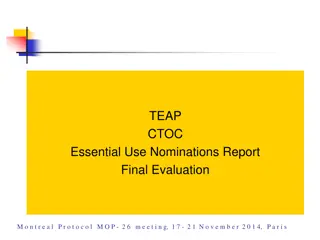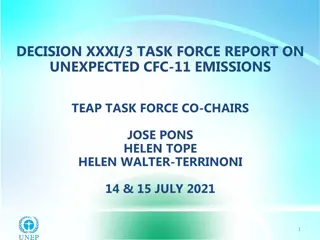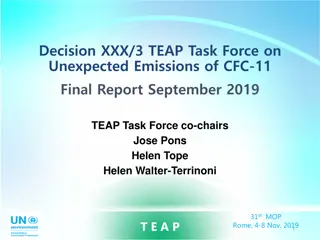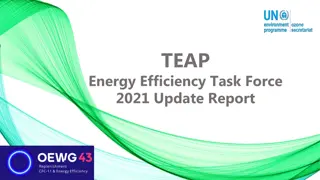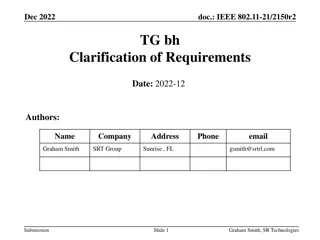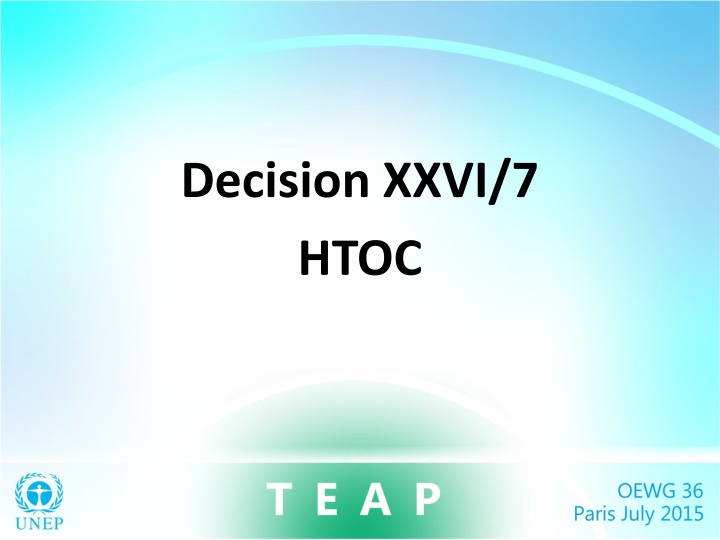
Regulatory Status of Halon Alternatives in Aircraft Industry
Explore the decision and current usage of halons in aircraft, including efforts to transition to alternatives, regulatory requirements, and industry challenges. Discover the timeline for phasing out halons and the development of non-halocarbon alternatives.
Download Presentation

Please find below an Image/Link to download the presentation.
The content on the website is provided AS IS for your information and personal use only. It may not be sold, licensed, or shared on other websites without obtaining consent from the author. If you encounter any issues during the download, it is possible that the publisher has removed the file from their server.
You are allowed to download the files provided on this website for personal or commercial use, subject to the condition that they are used lawfully. All files are the property of their respective owners.
The content on the website is provided AS IS for your information and personal use only. It may not be sold, licensed, or shared on other websites without obtaining consent from the author.
E N D
Presentation Transcript
Decision XXVI/7 HTOC
Decision XXVI/7 Decision XXVI/7 requested the TEAP, through its HTOC (a) To continue to liaise with the International Civil Aviation Organisation to facilitate the transition to halon alternatives, to approach the International Maritime Organisation to estimate the amount and purity of halon 1211 and 1301 available from the breaking of ships and to report information on global stocks of recovered halons to the parties in its 2015 Progress Report; (b)To report on existing and emerging alternatives for halons, including information on their characteristics and their rate of adoption, in particular for aviation uses Workgroup Dr. Daniel Verdonik, HTOC co-Chair David Catchpole, HTOC co-Chair Adam Chattaway, HTOC Member Robert Wickham, HTOC Member Thomas Cortina, HTOC Consulting Expert Bella Maranion, TEAP co-Chair (and former HTOC Member) Thanks to USEPA and its contractor ICF International for supporting analyses
Halon 1211 Use Handheld extinguishers Halon 1301 Use Lavatory Engine/APU Aircraft Rescue & Fire Fighting Cargo
New Design Aircraft Regulatory Status Requirement Lavatory Handheld Extinguisher Engine / APU Cargo ICAO Date International Agreed Changes 2011 2016 2014 Has Been Met By using HFCs 227ea/236fa Will not be met Could Be Met By Using HFCs 227ea/236fa or HCFC Blend B. Industry choosing not to meet this date while awaiting regulatory approval of 2-BTP. Will not be met HFC-125 has been proven by US military. Industry impediments are space and weight concerns & the high GWP of HFC-125 NA Date after which halons should not be used in completely new designs EU Cutoff Date EU Regulation 2011 2014 2014 2018 Should Be Met By using HFCs 227ea/236fa Could Be Met By Using HFCs 227ea/236fa Industry impediments are space and weight concerns and the high GWP of the HFCs Will not be met HFC-125 has been proven by US military. Impediments to civil aviation air frame manufacturers are space and weight concerns & the high GWP of HFC-125 Will not be met Halocarbons proven not to work. Industry estimates it will take until 2024 to develop a non-halocarbon alternative Date after which halons cannot be used in completely new designs in EU
Current ProductionAircraft Regulatory Status Requirement Lavatory Handheld Extinguisher Engine / APU Cargo ICAO Date International Agreed Changes 2011 2016 Has Been Met By using HFCs 227ea/236fa Will not be met Could Be Met By Using HFCs 227ea/236fa or HCFC Blend B. Industry choosing not to meet this date while awaiting regulatory approval of 2-BTP. NA NA Date after which halons should not be used in the production of aircraft EU End Date EU Regulation 2020 2025 2040 2040 Should Be Met By using HFCs 227ea/236fa Could Be Met By Using HFCs 227ea/236fa Industry impediments are space and weight concerns, and the high GWP of the HFCs. Might be met HFC-125 has been proven by US military. Long term development of halocarbon potential alternatives under way Might be met Industry estimates it will take 9 years to develop and implement non-halon system. Nitrogen/water mist system under development. New halocarbons yet to be evaluated Date after which halons cannot be used in the operation of aircraft - includes retrofit requirement
Status of Alternatives In Aviation Aircraft Rescue and Fire Fighting (ARFF) Halon 1211 used in large portable extinguishers and Fire Trucks HCFC-123 based Blend B has proven to be an effective alternative From an ODP and GWP basis, the best option to meet ICAO dates for on board halon 1211 replacement is the approved HCFC-123 based Blend B if 2-BTP is not approved Lack of Progress in Implementing Alternatives Only the smallest use of halon 1301 has been replaced with alternatives There is not going to be enough recycled halon 1301 for all uses All Civil Aircraft built today require halons in all but smallest use Civil Aircraft have long lifetimes until scrapped 20 40+ years Aircraft built this year need adequate replenishment supplies through at least 2035 - 2055 unless retrofit 9 year cargo bay system development time (i.e., new design in 2024)
open access website, http://www.world-ships.com/ Still attempting to purchase access to lifetime data to refine estimates 4,000 Halon 1301 Remaining in Service on Ships 3,500 3,000 (metric tonnes) 2,500 2,000 1,500 1,000 500 0 1975 1985 1995 2005 Year 2015 2025 2035 30-year lifetime 40-year lifetime Halon From Shipbreaking will last only 8 18 more years and it is not dedicated to civil aviation
Global Halon 1301 for Civil Aviation Use Not all halon 1301 in global bank will be available to civil aviation 41,000 43,000 t in global bank (SAP data and HTOC model) Subtract what is not available to civil aviation 17,000 t reserved for future use in ground-based fire protection systems in Japan About 4,600 t reserved by the U.S. military for use in existing critical weapons systems About 1,500 t of halon 1301 in oil facilities on the North Slope of Alaska and other places around the world About 2,200 t already installed on civil aircraft rising to 6,000 t by 2050 Leaves 14,000 17,000 t (33% - 40%) for civil aviation if every other gram of halon 1301 becomes dedicated to civil aviation Global and Civil Aviation emission rates will play an important role in how long civil aviation can be supported HTOC ~3% and SAP data ~4% of bank / year Anecdotal information places civil aviation closer to 5% / year
High Annual Aviation Emission Rate; ~14,000 t Aviation Demand Deficit 14,000 Total Aviation Demand 12,000 Tonnes of Halon 1301 Computer Facilities 10,000 Maritime 8,000 Aviation Bank 6,000 4,000 2,000 - 2014 2019 2024 2029 2034 2039 Low Annual Aviation Emission Rate; ~17,000 t runs out in 2045 Not enough halon 1301 in global bank to support civil aviation over 20 - 40 year life of aircraft
Takeaway Messages 1. Globally, there are adequate supplies of halon 1211 at this point On an ODP/GWP basis the best option to meet ICAO dates for on board halon 1211 replacement is HCFC-123 based Blend B if 2-BTP is not approved Industry is producing aircraft that will not have access to recycled halon 1301 over their lifetimes Therefore, we find it nearly indisputable that Civil Aviation will need production of new halon 1301 in the future Average age of some civil aircraft when scrapped is more than 40 yrs There is a lack of progress in implementing halon alternatives in Civil Aviation 2. 3.

